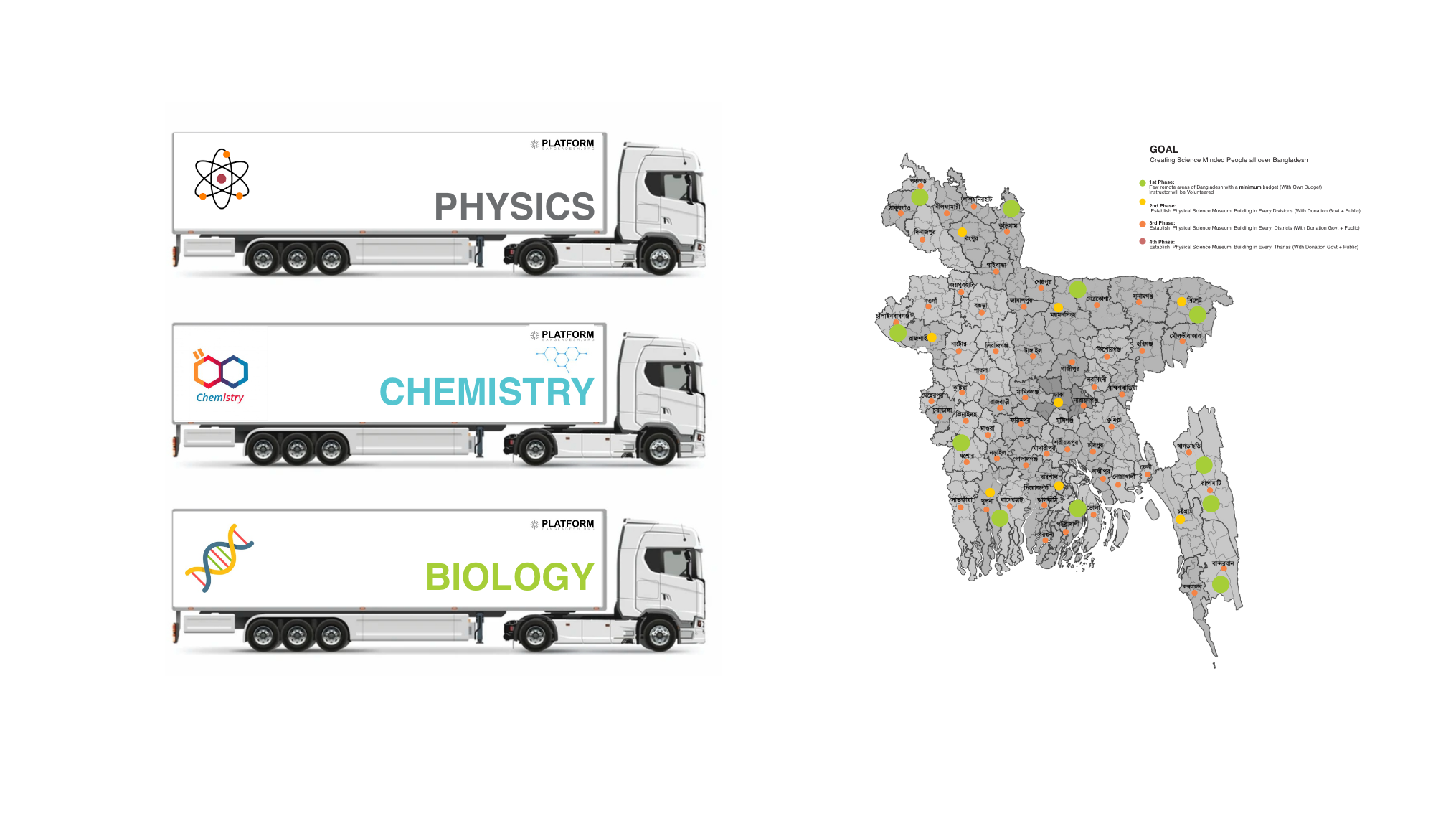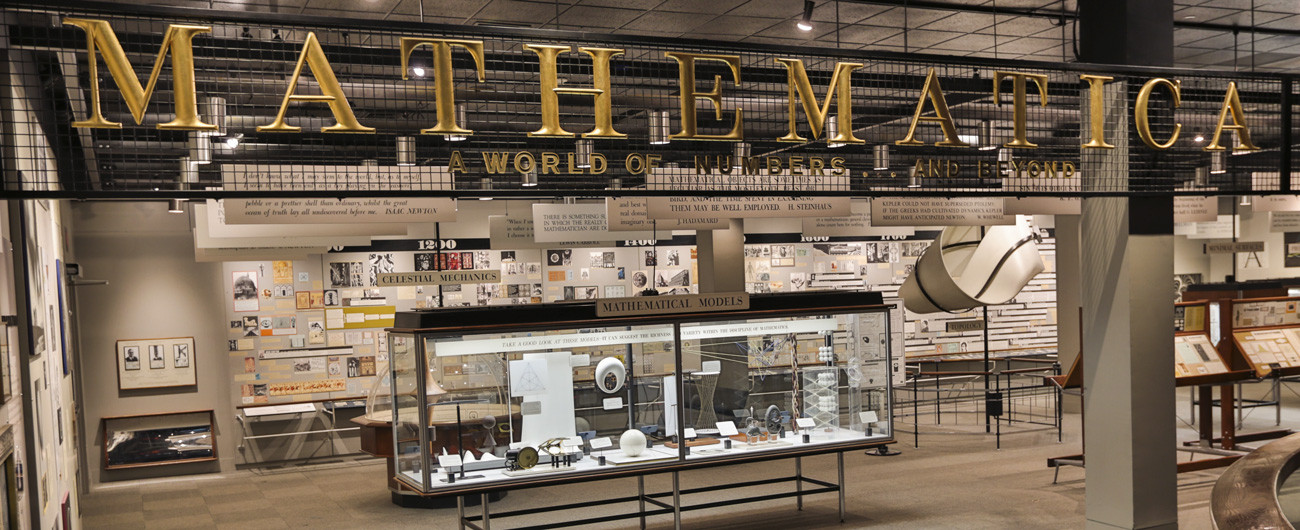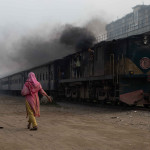Science Museum in Bangladesh
Mobile Learning Units & Mobile Science Museum Initiative Background
In Bangladesh, many rural and remote regions still lack fundamental educational infrastructure. Limited access to quality education — particularly in science, technology, engineering, and mathematics (STEM) — contributes to high dropout rates and limited career pathways for young people. Moreover, there is a significant gap in public engagement with science, particularly among underrepresented groups like girls and economically disadvantaged communities.
Rationale
Mobile learning units and container-based science museums present a highly adaptable, cost-effective way to deliver education and inspiration where permanent infrastructure is lacking. These mobile hubs are ideal for reaching isolated communities, offering practical, interactive learning experiences that boost retention and foster curiosity.
Implementation Strategy
1. Vehicle & Container Conversion
- Retrofit buses or shipping containers into fully equipped mobile classrooms and science museums.
- Equip with books, solar panels, tablets, projectors, and hands-on educational tools.
- Design spaces with modularity and accessibility in mind to maximize space and inclusivity.
2. Phased Development of the Science Museum
- Phase 1: Launch Mobile Science Museums in containers across rural areas with minimal budgets and volunteer STEM educators.
- Phase 2: Scale up with more mobile units and add semi-permanent hubs in sub-districts (thanas).
- Phase 3: Establish full-scale science museum buildings in each division and district.
- Phase 4: Ensure permanent museums in every thana through public and government donations.
3. Interactive Learning Experiences
- Use science kits, digital apps, touchscreen games, and VR/AR experiences.
- Include multi-disciplinary exhibits:
- Physics: Mechanics, optics, sound, thermodynamics, electricity.
- Mathematics: Geometry, probability, puzzles, and real-life math applications.
- Chemistry: Periodic table, molecular models, chemical reactions.
- Biology: Human anatomy, ecology, biodiversity, genetics, and evolution.
- Engineering & Technology: Robotics, computer science, civil and mechanical systems.
4. Rotational Scheduling
- Create a monthly route plan in collaboration with local education offices.
- Coordinate with schools to ensure optimal participation during visits.
5. Community and Cultural Engagement
- Incorporate local scientific achievements, environmental issues, and folklore.
- Use community events to build ownership and participation.
Design Competition for Container Science Museum
Core Idea
Launch a design competition inviting architecture, industrial design, and interior design students from universities across Bangladesh (and possibly internationally) to create the first-ever container-based science museum specifically tailored for children in remote areas.
Objectives
- Innovative Design Solutions: Tap into the creativity and fresh perspectives of design students to create an engaging, sustainable, and functional mobile museum.
- Educational Opportunity: Offer students a real-world challenge with a socially impactful project.
- Community Involvement: Foster pride and participation by showcasing Bangladeshi student talent.
- Cost-Effective Launch: Avoid high consultant fees by using crowd-sourced talent and rewarding top submissions with scholarships or recognition.
Competition Structure
- Call for Submissions
- Theme: “Design for Impact: A Science Museum in a Box”
- Target Audience: Primary and secondary school children in rural areas
- Submission Requirements: Floor plan, interior layout, material specs, sustainability strategy, interactive exhibit ideas
- Judging Panel
- Include professionals from architecture, education, museum studies, and child psychology.
- Criteria: Creativity, usability, sustainability, cost, educational value, inclusivity.
- Winning Design Implementation
- The first-prize design will be used to build a real container science museum prototype.
- Students may also be involved in the build, gaining hands-on experience.
- Awards and Recognition
- Winners receive stipends, internships, certificates, and the chance to present at the museum's launch event.
Design Considerations for Mobile Science Museum
Design Considerations for Mobile Science Museum
- Modular Structure: Easy transport and setup in various terrains.
- Interactive Exhibits: Hands-on learning over passive display.
- Ventilation & Light: Incorporate solar lighting and eco-friendly air flow systems.
- Safety & Security: Durable, lockable containers with fire safety features.
- Cultural Branding: Use national colors, local art, and bilingual signage.
- Flexibility: Adaptable interior layouts for different learning themes.
Expected Outcomes
Education Access
- Dramatic increase in STEM education access for children in remote and underserved regions.
- Students experience hands-on, experimental learning that textbooks alone can’t provide.
Equity and Inclusion
- Focus on involving girls and underrepresented groups in science and engineering education.
- Programs designed for children with disabilities and minority language groups.
Public Engagement and Awareness
- Builds a nationwide appreciation for science and innovation.
- Encourages families and communities to value and support education.
Innovation and Career Development
- Sparks interest in future STEM careers.
- Lays groundwork for a generation of problem solvers and critical thinkers.
Sustainability
- Mobile units run on solar energy, minimizing carbon footprint.
- Reuse of containers promotes eco-friendly construction.
Why Bangladesh Needs a Science Museum in a Container
- Accessibility: Brings STEM education directly to areas lacking facilities.
- Engagement: Hands-on exhibits increase learning retention and excitement.
- Versatility: Adaptable to age, region, culture, and theme.
- Low Cost: More affordable than constructing permanent museums initially.
- Inspiration: Inspires science-minded citizens to innovate and solve local challenges.
- Tourism & Culture: Over time, regional science museums can also attract tourism and enhance cultural reputation.




